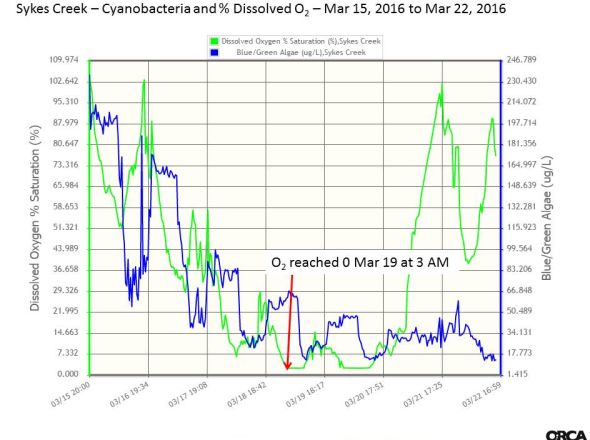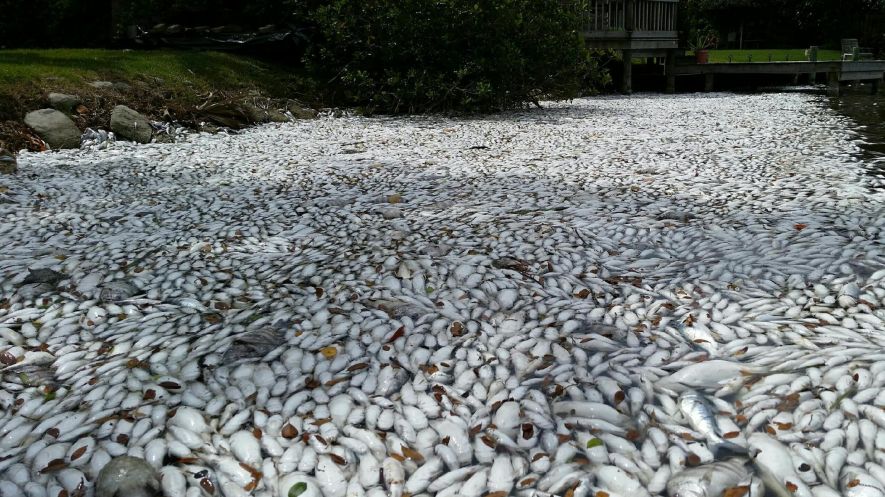Florida is reeling from an unprecedented fish kill in the Northern Indian River Lagoon, along the state’s eastern coastline.
In search of data to help understand such events, one group of researchers, led by Ocean Research & Conservation Association (ORCA) founder Edie Widder, provides an in situ tool, funded by the State of Florida, that can help track the health of the Lagoon, in a format that is easy to digest and which supports ongoing statistical analysis of this unique and valuable ecosystem.
Observing data from the in situ Kilroy monitors, the cause of the latest Florida fish kill is easy to understand. A large brown algae bloom inundated the Indian River and Banana River Lagoons beginning in early January 2016. As that algae bloom began to die off, bacteria consuming the dead algae were also consuming oxygen. The oxygen bottomed out at 3 AM on 19 March 2016, suffocating fish and other wildlife. The result was devastating.

The Ocean Research & Conservation Association (ORCA) has a water quality monitoring system of Kilroys throughout the length of the IRL including the northern area where the fish kill occurred. The algae bloom that led to the hypoxia event (loss of sufficient oxygen to sustain the fish) started at the beginning of January. As that algae bloom began to die off, bacteria consuming the dead algae were also consuming oxygen. As shown in the graph from Sykes Creek, the oxygen bottomed out at 3 AM on 19 March 2016. All data comes from ORCA. Funding for Kilroys deployed in the Indian River Lagoon was provided by the State of Florida.
Paradise Lost
The scope of this fish kill is daunting. Hundreds of thousands of dead fish went belly up across at least 30 miles of the Northern Indian River Lagoon, a gorgeous stretch often referred to as one of the world’s most diverse ecosystems. Observers say that at least 15 species were wiped out in the region, and it is expected that a full recovery will take years, if not decades.
One expert, Kelly Richmond of the Florida Fish and Wildlife Research Institute told CNN that “fish kills happen all the time” but this is quite unusual as it's “a massive kill.”
The massive fish kill did not discriminate. Captain Alex Gorichky, who runs a fishing tour company, told the New Times that every species of fish in the lagoon was affected and added, “We’re going to have a serious problem once they start decaying.”
Gorichky also reminded everyone that while the dead fish are visible on the surface of the water, species such as snail, conch, and crab are hidden from view. In truth, the crisis is not over, nor even fully quantified at this date.
The Government’s Response
In a press conference held after the fish kill became national news, Florida Governor Rick Scott said, “I applaud our state agencies for working together to quickly determine the effects of this recent event, and we will continue to do all we can to protect water quality in the Indian River Lagoon.”
Few in the state would agree that the governor has done all he can to protect the lagoon system, but it is worth noting that an $82 billion budget that Scott signed in March 2016 includes $21.5 million to dredge the central and northern Indian River Lagoon and the Banana River in Brevard County, in an effort to reduce nutrients in the sediment there. The state is aware that there is a problem, which is why they funded a project like the deployment of Kilroy’s.
Conservationists like Indian Riverkeeper Marty Baum, who assisted with deployment of the Kilroys, are able to use data gathered by the devices to confirm that nitrogen levels had been elevated in the system for months prior to the critical event.
Data like this is why continued monitoring may be the solution to connecting the dots when it comes to preventing future fish kills.
According to Edie Widder, “Too often monitoring is implemented only in degraded ecosystems in attempts to stop and hopefully reverse the decline. But reversal requires knowledge of what ‘healthy’ looks like.”
Longterm monitoring can establish a baseline. It can also make something like the impact of pollution on the life cycles of the Indian River Lagoon visible and empower decision-makers to act in the best interest of Florida’s waterways. In fact, raw historical data from the project is available to the public via a web interface located here.
What else is being done?
According to the Florida Department of Environmental Protection (DEP), “Local, state and federal agencies will continue to work together to find answers to the cause of this brown tide and to identify what can be done in the future to limit or avoid similar events and build on restoration efforts underway. DEP and SJRWMD have deployed staff and boats to assist Brevard County with their local recovery and clean-up efforts, and local Department of Health (DOH) offices continue to monitor for human health impacts and encourage public safety.”
DEP’s list of short and long-term response efforts can be found here.
An interview with Edie Widder, explaining the inspiration and the technology behind ORCA appeared in the July 2014 issue of ECO.
One thing is for sure: the solution to the Indian River Lagoon’s tribulations will include data from Kilroy™ monitors. Hardly larger than a football, at a fraction of the cost of other sensors, each Kilroy™ monitors the lagoon’s speed, direction, temperature, depth. Fluid though it appears, water flows in packets that can be identified by their temperature, salinity, speed, direction as well as other parameters. These packets of water have a tendency to either pick-up, carry, or drop payloads of sediments, nutrients, and pollutants, all of which can be monitored with Kilroy. What’s more, it does so, 24 hours a day, 365 days a year, and provides a historical perspective that enriches “after the fact” observations exponentially.
At the launching of Kilroys in the Indian River Lagoon in 2009, U.S. Rep. Tom Rooney, R-Tequesta, said, “Recent economic valuations estimate that the Indian River Lagoon provides approximately $3.7 billion per year in benefits to Florida’s residents and visitors — and recreation, including fishing, boating and swimming, is the largest component of the lagoon’s economic value. I’m interested in ORCA’s Kilroy technology because of its potential to ensure these waters will remain healthy and vibrant for generations to come.”
To view a CNN video about the fish kill, click here.
A video about the problem of dead fish causing a massive stench can be viewed here.
More on the dire state of Florida’s ecosystem health can be found here.
To visit ORCA online, click here.



